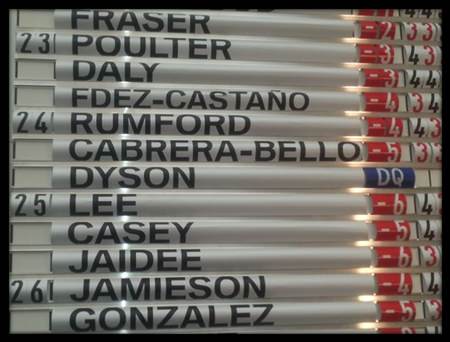This is a continuation of last week’s article covering the more unusual situations revealed by the R&A’s Rules Report, on this year’s Open Championship played at Muirfield.
As mentioned, the report states the majority of Muirfield’s rulings were simple affairs such as unplayable ball (18 rulings), identifying ball (17), interference from movable obstructions like cables (20) and relief from immovable obstructions such as sprinkler heads (29). Now to continue where last week left off:
Identifying Ball: During his third round, Martin Laird suffered two unplayable lies where he chose to drop – each one under penalty of one shot. Later in the same round he again found thick rough. A ball-spotter found a ball that Laird thought could be his, but he needed to make sure. After announcing to the spotter his intentions, he marked and lifted it just far enough to confirm that it was in fact his ball.
 Something we don’t want to see – DQ.
Something we don’t want to see – DQ.
A player is entitled to do what Laird did, however, he must make his intentions known to either his marker, fellow-competitor or a referee and give them the opportunity to observe the entire process – Rule 12-2. Unfortunately for Laird, notifying the spotter doesn’t cut it, thus the one stroke penalty.
Club Damaged Other than in Normal Course of Play: Charl Schwartzel’s first round frustrations came to a head on the 15th. Immediately after playing a bad shot he threw his club to the ground in disgust. The 8-iron broke in two on hitting the hard ground which meant he had to complete the round without it. Given the club was not broken during the normal course of play, the club may not be used nor replaced during that round – Rule 4-3b. Penalty for breach of rule; disqualification.
Disqualification through use of Non-conforming Driver: Moving away from the Open, there was a more recent incidence involving new technology that should concern us all. Charles Howell III was DQ’d for using a non-conforming driver during a PGA Tour event in August. Exactly why the driver was declared non-conforming is the interesting bit.
Howell was using the new SLDR driver from TaylorMade – the one that allows adjustment of a small weight along a track positioned on the sole of the club. Next to the track is a small weight port covered by a cap. This cap is removed when the golfer wants to change weights.
While warming up on the practise range prior to his second round, the cap was lost after it came off. Howell checked with TaylorMade officials who told him the club’s performance wouldn’t be affected. He thus used the driver minus the cap and finished the round tied in 10th place.
The following day rules officials told Howell that the missing cap made the driver non-conforming – and because he had used it the previous day, he was disqualified.
The lesson is that the clubs we use must be identical to that the manufacturer sent to the officiating body for testing – in every way.
Interestingly, had the cap dislodged itself after Howell had commenced his round (damaged in the normal course of play), there wouldn’t have been a problem – providing he fixed it prior to the next round.
Touching the Line of Putt: Another disqualification occurred during October’s BMW Masters in Shanghai. Englishman Simon Dyson was about to commence his third round, in a tie for second, when officials informed him he had been DQ’d for a breach of Rule 16-1a.
They then showed him a video taken from his round the previous day. It showed the golfer marking his ball before lifting then using the ball to tap down a mark that was on his line of putt. The actions, seen plainly in the video, appear to be that of an unthinking golfer having a brain-fade rather than of someone deliberately flouting the rules. An impression supported by Dyson himself, who said after seeing the incident replayed, “I still can’t recall doing it.”
The incident saw Dyson appear before the European Tour’s disciplinary panel where he was found guilty of a serious breach of the tour’s code of behaviour, fined UKP30, 000 and given a two-month ban, suspended for 18 months. He was adjudged to have deliberately tapped down a spike mark on the line of his putt in the full knowledge he was breaking Rule 16-1a of the Rules of Golf, with the purpose of improving his position on the green.
Compared to other sports, this may appear somewhat trivial. In golf, however, that is far from the case. As the hearing noted, “Conduct such as that committed by Mr Dyson is a very serious matter, which in other circumstances would warrant suspension from the tour.”
God forbid that we golfers in Pattaya should ever do such a thing – we have caddies for that.
Golfnutter.




